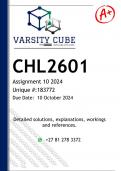CHL2601
Assignment 10 2024
Unique #:183772
Due Date: 10 October 2024
Detailed solutions, explanations, workings
and references.
+27 81 278 3372
, QUESTION 1
1.1.
Frustrational level: Books at this level should have extensive teacher support. You
might select texts with simple narratives and repetitive structures, but they contain
more complex vocabulary or sentence structures that learners find challenging.
Some examples could include:
• "Green Eggs and Ham" by Dr. Seuss (simple sentences but with some tricky
words)
• "Where the Wild Things Are" by Maurice Sendak (more advanced
vocabulary and concepts)
• "The Cat in the Hat" by Dr. Seuss (rhythmic and repetitive, but some complex
words).
Instructional reading level: At this level, books should be challenging but
manageable with some support from the teacher. Books that have familiar themes
but introduce new vocabulary or slightly more complex sentence structures are
ideal. Some examples include:
• "Brown Bear, Brown Bear, What Do You See?" by Bill Martin Jr. (predictable
text but introduces new animals and descriptive words)
• "Frog and Toad Are Friends" by Arnold Lobel (stories with familiar
vocabulary but some new words)
• "Pete the Cat: I Love My White Shoes" by Eric Litwin (engaging storylines
with slightly more difficult vocabulary).
Independent reading level: These books are easy for the learners to read on their
own, without much help. They contain familiar vocabulary, straightforward sentence
structures, and engaging illustrations to support comprehension. Some examples
include:
Varsity Cube 2024 +27 81 278 3372
, • "The Very Hungry Caterpillar" by Eric Carle (easy-to-follow, repetitive
structure)
• "Goodnight Moon" by Margaret Wise Brown (simple, predictable text)
• "Don’t Let the Pigeon Drive the Bus!" by Mo Willems (familiar, everyday
language with engaging illustrations).
1.2.
To make reading "cool" for Foundation Phase learners, here are three innovative
and creative ideas:
1. Interactive Storytelling with Props and Costumes: Engage students by
bringing stories to life through role-playing and props. For example, when
reading "The Very Hungry Caterpillar", the teacher can use a puppet of the
caterpillar and let the learners act out the story. Using costumes and props
encourages learners to associate reading with fun and creativity, making
them excited about participating.
2. Digital Storytime with Animated Books: Incorporating technology through
animated reading apps or e-books can make reading more interactive. Apps
like Epic! or FarFaria allow learners to follow along as stories are read aloud
with animations that capture their attention. Additionally, allowing them to
create their own simple animations based on books they’ve read can spark
creativity and interest in reading.
3. Reading Challenges and Book Treasure Hunts: Turn reading into a game
by creating classroom reading challenges, where learners earn points or
rewards for completing books at their level. Alternatively, a “Book Treasure
Hunt” can be set up, where learners must solve clues that lead to different
reading stations around the classroom, encouraging exploration and
discovery of new stories.
These ideas will make reading both engaging and enjoyable for Foundation Phase
learners, helping them view it as a fun activity rather than a task.
Varsity Cube 2024 +27 81 278 3372





